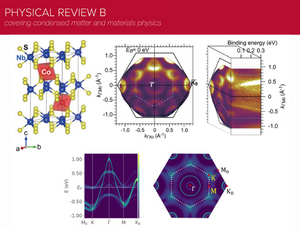
 Web Content Display
Web Content Display
SOLARIS centre
 Web Content Display
Web Content Display
 Web Content Display
Web Content Display
Role of intercalated cobalt in the electronic structure of Co1/3NbS2

A team of scientists from Zagreb, Wien, Lausanne and Krakow led by Dr. Eduard Tutiš has investigated an antiferromagnetic layered compound Co1/3NbS2 - an example of the transition metal dichalcogenide (TMD), having complex magnetic structure.
Scientists have used angle-resolved photoemission spectroscopy (at UARPES beamline, SOLARIS Centre) to obtain detailed insights into complex electron-electron and electron–lattice interactions in the solid. The observed electronic structure of Co1/3NbS2 resembles the parent material 2H-NbS2, however, some significant departures are observed, which cannot be explained by the rigid band shift with minor deformation of bands.
The first author of the publication, Dr. Petar Popčević, explains the main idea behind the conducted experiment:
The materials made of alternating metallic and magnetic atomic layers continue to promise and deliver new magnetic orderings and electronic states. Co1/3NbS2 represents such material, with pronounced magnetic frustration and the lowest magnetic ordering temperature among similar systems. The paper brings the study of the electronic structure through angle-resolved photoelectron spectroscopy (ARPES), accompanied by extensive comparison to ab initio calculations and modeling. The data suggest that magnetic Co ions provide the dominant bridges for electronic conduction in the direction perpendicular to layers. The nature of the connection strongly depends on magnetic configuration. The strong mixing between itinerant and magnetic degrees of freedom is argued to be responsible for the band observed at the Fermi level, in the form of a necklace composed of shallow and wide electronic pockets. The band is entirely unforeseen by usual electronic structure calculations, indicating an example of a strongly correlated electronic system where the coupling between layers plays an exquisite role.
Link to the full publication -
Role of intercalated cobalt in the electronic structure of Co1/3NbS2
